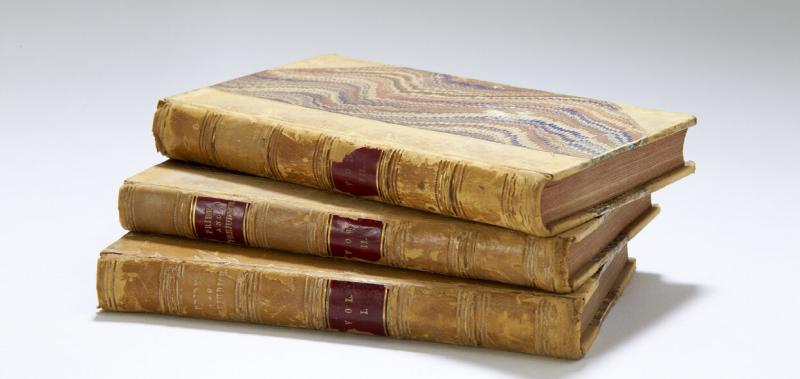Why Jane Austen's Novels Matter
By: Kathryn Sutherland - Jane Austens House

Why Jane Austen's Novels Matter
Professor Kathryn Sutherland on why Jane Austen was a pioneer in fiction, breaking new ground in subject and style
She died at 41, leaving six slim fictions (slim, according to the bulky standards of her time), their subject matter and settings similarly limited in scope: village life among the gentry in England's southern counties; prudent love affairs in Surrey, Hertfordshire, and Bath, where bank balances and romance are in harmonious agreement. Before her death, she had the satisfaction of receiving one major critical review, steady though not spectacular sales, and the knowledge that her work was admired by discerning readers. Not much, you might think, to build a global reputation on.
Her earliest readers said they felt they knew her characters, and from the start readers sensed she was taking the novel in a new direction. She rejected the sensational plots and surprising revelations of much contemporary fiction in favour of social behaviour minutely observed and the emotional and moral development of a thoughtful heroine. What is really new in Austen's fiction is the way she appears to bring art and life closer together, especially in describing the inwardness of the heroine, whose busy life of the mind replaces the improbable adventures in the body of so much popular fiction of her day. She worked a quiet revolution in the novel that was not fully appreciated until the modernist writers of the early twentieth century: until Virginia Woolf, for example.
Jane Austen was a pioneer in fiction, breaking new ground in subject and style. She saw that everyday events in ordinary places could be the stuff of fiction. Her social range may be narrow, confined to her own rank in society, but she has a universal comic wit. Her novels are talking shops, and she wrote brilliant natural-sounding conversation, her characters coming to life as they speak—a skill that very few novelists then or now possess. Though her stories have only slight visible structure—what Woolf called 'parties, picnics, and country dances'—they nevertheless tap into something deep in our social and individual consciousness, regardless of our culture and life experiences. Her subjects are the behaviour of parents towards children, the need to get on with neighbours, the dangers and pleasures of falling in love, of making friends, and, above all, the importance of discriminating between those who mean us well and those who may not.
Her heroines have inner lives, represented on the page as a kind of conversation with the self. They know life's everyday frustrations and boredom; they feel the limits society places on them. Though her fiction and her ethic (her system of morals and behaviour) are centred in the lives of women, her novels register the longing in each of us to grow, to change, to become other. What Elizabeth Bennet and Mr Darcy, Emma Woodhouse and Mr Knightley, and Anne Elliot and Captain Wentworth find, against the odds, is emotional communication, belonging. At their best, her male characters too have emotional intelligence. Her characters are real to us and we learn from them; through them, our own limitations may become a little less constraining. The extraordinary intimacy Austen's novels inspire in her readers, male and female, springs from this. She nourishes our emotional intelligence. That is what great literature does.
And this is why Jane Austen has long held such a high and unusual position within English Literature: admired and discussed by scholars and critics, and loved by readers the world over as almost a friend.
Kathryn Sutherland

Kathryn Sutherland is Professor of English and Senior Research Fellow at St. Anne's College, Oxford. Her publications include Jane Austen's Textual Lives: from Aeschylus to Bollywood (2005), Jane Austen: Writer in the World (2017), and Jane Austen's Fiction Manuscripts (2018). Her latest book is Why Modern Manuscripts Matter (2022), a study of the politics, commerce, and aesthetics of heritage culture in the shape of authors' manuscripts, including those of Jane Austen.
The Code of Conduct and Terms of Service must be complied with.
Anything posted about current politics or religion not relevant to Jane Austen and/or the topics referred to in the group description above will be deleted as "off topic".
Videos or images or links to sources that the Administration cannot open must be described or explained when requested or they will be deleted.





This is the best and simplest explanation of Jane Austen's novels I've ever seen.
This was a test to see if anyone was AT LEAST as interested in English literature as they are in political bullshit. I guess I'm the only one - not a comment or a vote up - quickly wiped off the Front (Home) page. No surprise, just a readjustment of my respect.
You are not the only one and my aging 'wisdom' is exploring Emma for a third time.
Of course, it takes a Canadian to show their propensity for English Literature.
There is also a 24 part lecture series The Life and Works of Jane Austen by Devoney Looser PhD.
Course Overview
In 1811, a novel was published anonymously, by an author identified as “A Lady.” It did moderately well for a book of that kind. Little did anyone suspect that this novel would be the start of a literary legacy that would grow over the course of two centuries and cement its author as one of the greatest novelists in the English language.
The novel was Sense and Sensibility , and the unnamed “Lady” was Jane Austen. Born to the ranks of the lower gentry in 1775, Austen led what some have mistakenly described as an ordinary and unremarkable life—a life that ended too early, at the age of 41. But from this life, Austen drew inspiration for six novels that all rank as literary masterpieces, including the widely beloved Pride and Prejudice . So, what do we really know about Austen’s life and influences? What can a better understanding of her historical, cultural, and literary context tell us about how her brilliant work came to rank alongside Shakespeare, Eliot, and Dickens in the pantheon of revered British writers? Why does her work continue to resonate with readers from all walks of life and to inspire theater, film, television, and literary adaptations? Why do her deeply devoted fans continue to make pilgrimages to her home and celebrate her life 200 years after her death?
With Professor Devoney Looser of Arizona State University, you will delve into Austen’s everyday realities in the elegant and tumultuous Regency period and emerge with a more thorough understanding of her influence and lasting legacy. Over the course of the 24 lessons of The Life and Works of Jane Austen , you will explore her six completed works, as well as her raucous teenage writings and unfinished novels. You will also get a guided tour of Austen’s world—the politics, social dynamics, major events, cultural markers, and class structures that defined the late 18th and early 19th centuries in Great Britain and how these elements shaped her life and inspired her work. While a certain amount of mystery about Austen’s life will always exist, this course offers a fuller understanding of her world and how she brilliantly captured it on the page.
That's a good post but I'm unable to open the link. If it leads to and advertises a course that requires payment it is spam and will have to be deleted.
The rest:
A Truth Universally Acknowledged
Jane Austen’s books were published in the relatively brief period known as the Regency. In order to really understand and appreciate the nuances of novels like Sense and Sensibility and Mansfield Park, it’s necessary to grasp the unique historical and social context of this fascinating period. Throughout the course, you will learn about the individual, cultural, and economic dimensions of the Regency, such as:
The insight Professor Looser provides into these contexts should enhance your experience of Jane Austen’s novels, as well as expand your ability to understand and appreciate the literature, history, and social dimensions of the late 18th and early 19th centuries more broadly.
Two Inches of Ivory
In a letter to her niece, Jane Austen offered the writing advice that “three or four families in a country village is the very thing to work on.” This small, domestic scale defined the parameters of Austen’s work and reflected part of her own reality. Yet within this workspace—what she once referred to as “two inches of ivory, on which I work with so fine a brush”—Austen captured a broad range of experience through her heroines and her cast of vividly realized characters.
The Regency setting and close, personal scope of her stories have fooled many a would-be reader into believing that Austen wrote sedate, ladylike romances centered on the marriages at the end of her novels. But what often goes overlooked is Austen’s comedy—her sharp, satirical eye picks apart the highly stratified society she so sharply observes. Even her most ridiculous characters still read as true to life today. As you will see in Austen’s letters, her biting critique of the rakes, snobs, and fools that populate her fiction were fodder for gossip and ridicule in her own life as well.
And although some critics have argued that Austen conspicuously left some of the most pressing events and issues of her day out of her fiction, you will discover how often these inescapable realities affected her life and did, in fact, find their way into her work. Whether she was touching obliquely on something as serious as the impact of the Napoleonic Wars in Pride and Prejudice and in Persuasion, or more directly—and lovingly—poking fun at the popular fiction of the day in Northanger Abbey, Austen’s fiction is deeply informed by her own experiences and world events.
Austen’s work was shaped profoundly by the world she lived in. The Life and Works of Jane Austen offers you the chance to explore this world and to see how the novels Austen published over two centuries ago continue to engage and entertain readers, and to influence popular culture through countless adaptations on page and screen. Whether you are a fan, a casual reader, or even someone who has always been a little confused by “Austenmania,” this course will illuminate the worlds, both real and imagined, of Austen’s astonishing contributions to literature.
Even though the movie Becoming Jane fictionalizes Jane's life it is not altogether incorrect. Much is made of the relationship of money and social class with respect to matrimony.